Equateur : Along the
volcano Range
-
 Nature here is superbe although agressive,
altitude sickness, unpradictable weather... The mountains of
the Equator are hard work ! Especially the ascent of Cotopaxi,
nearly 6000 m high... A reportage carried out for VSD during
the French trek named Raid Gauloise 98. Nature here is superbe although agressive,
altitude sickness, unpradictable weather... The mountains of
the Equator are hard work ! Especially the ascent of Cotopaxi,
nearly 6000 m high... A reportage carried out for VSD during
the French trek named Raid Gauloise 98.
-
- Texts and photography by
Jean-François Vibert
-
- (The account bellow is specifically
to do with the Raid Gauloises 98)
-
- Nearly 6000 m high, the hardest
trek yet - This is the
first time in the nine Raid Gauloises that a 6000 m high obstacle
has been put in the path of the contesters. True, 37 out of the
49 teams will make it to the top of the volcono called Cotopaxi...
But at what price !
-
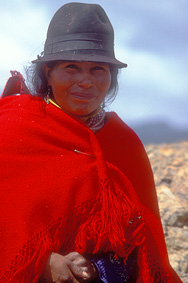 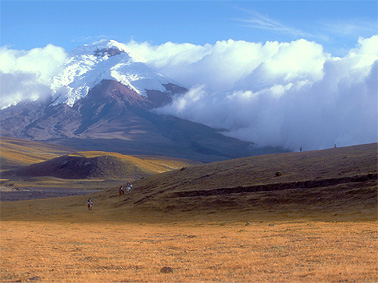
-
- After seven hours effort
- Emma and the five girls
from the Buff-Salomon team can, at last, see the summit. Nearly
6000 m up their breathing is difficult, their strengh is diminished
by 30 % and the effort needed for every step they take seems
impossible to raise. The only all women's team has succeded in
what it set out to do : conquer the volcano. From here, the refuge,
which is 4800 m up (nearly as high as the Mont-Blanc), cannot
be seen. Any problem now would be bad news as the emergency helicopter
would probably not come this far up. "The trek has never
been so hard" gasps the 25 year old Spanish girl. "I
remember my first one in Argentina. We had no strategic plan
especially where food was concerned. For two days we had to share
one soup between five of us ! I've never been so hungry in all
my life... But this year I think it's even harder." Of course
the newest and biggest difficulty of this nineth Raid Gaulois
is the great altitude to which they climb. It is also the most
dangerous : Acute altitude sickness can cripple and even kill
the most experienced mountaineers.
-
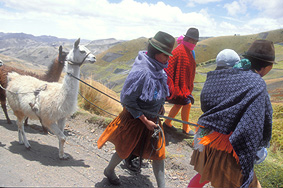 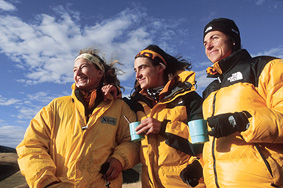
-
- The tone is set from the
start - To reduce the
risk of accidents, the teams arrived several weeks before the
event. At three thousand metres this aclimatisation period is
necessary to get used to the low amount of oxigen in the atmosphere.
As a result the body produces more red cells during the night
which contain hemoglobine and turn oxigen into energy. The starting
line is at 3500 m and the big day is fixed for saturday 19 september.
Some teams get off to a running start risking life and limb.
Many people give up in the following few hours. The ground is
soft, covered in high slippery grass due to incessant rain and
progression quickly becomes an ordeal.
-
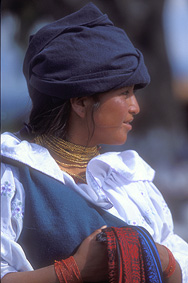 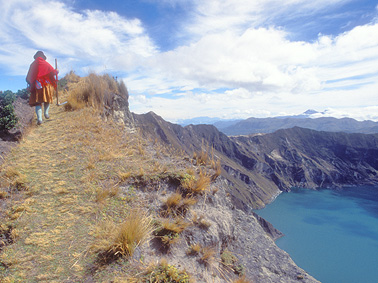
-
- A few days later - Due to the fog and moonless nights,
even the teams with the best sense of direction are lost . Dispersed,
the teams arrive at the foot of Cotopaxi, the highest active
volcano in the world. The first to get there are the extra fit
professional New-Zeland and American teams from Présidio-Solomon
a little ahead of the Franco, Spanish, Italien and American teams
from Spie-Batignole... That's how it goes : so as to get the
best, the teams are often multinational. After a 97 km orientation
walk and a 35 km "ride and run" (an original idea where
five contesters share three horses riding and running at the
same time) the morale of these ten, at least, still seems to
be exellent.
-
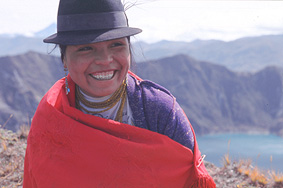 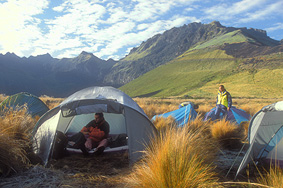
-
- A first with a high risk
factor - Although not
technically demanding, the ascension of the "Coto"
is seen to be a very hard climb. "At an altitude of 4800
m, the first night, I didn't get a wink at all " remembers
Michel william recent winner of the Camel Trophy. "When
I studied altitude sickness at university, she says, I never
thought that, one day, it would directly concern me ! It all
starts at 3500 m. The first symtoms are headaches,nausia, dizzy
spells, insomnia, anorexia... You can count one point for each
symtom : If you have less than three points you're doing well,
you must dink till your urine is as clear as water and take asperin
because it helps prevent frostbite."
-
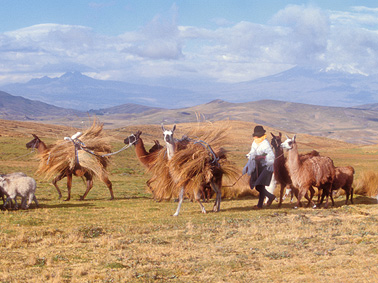 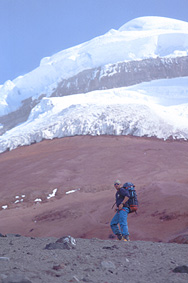
-
- Things start to get tough
when the symptoms are around the two mark - Vomiting and headaches that won't go away with
asperin. After four points you have to stop climbing because
then arrive the three 666 : breathing difficulties, pissing becomes
impossible, overwhelming tiredness..."In this case you'd
really better start going down quick ! Otherwise the lack of
oxigen in the blood can cause a pulmanary oedema which makes
you cough up pink foam (a mixture of water, air and blood). I
heard that your face can blow up like a ballon, your nose and
ears become blue. Then you have a cerebral oedema folowed by
a coma... If that happens there's only one thing to do : you
must be put in a decompression chamber urgently (if you can get
to one) and lose altitude artificially. Otherwise your dead."
-
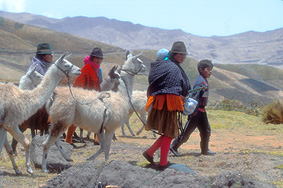 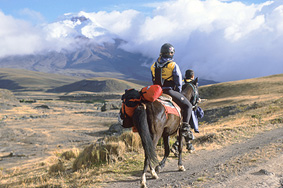
-
- The importance of perfectly
adapted equipment - It's
hard to tell beforehand who will be subject to altitude sickness.
It has nothing to do with training or how fit a person is. The
sickness hits individuals arbitrarily. Before embarking on a
journey to the summit, the organisation obliges all the participants
to pass a medical test . The doctor measures the amount of oxigen
in the blood with an electrical machine : less than 60% and you're
out. Because of the dangers linked to altitude, every piece of
equipment has to be checked. If a participent has forgotten something
then they can't go. But the stewards in charge cannot check everything,
thus the unhappy story of this Belge participant who decided
to go ahead despite the fact that he had no underpants on under
his trousers.
-
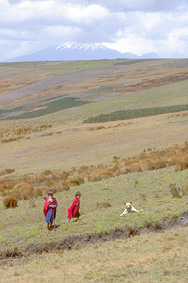 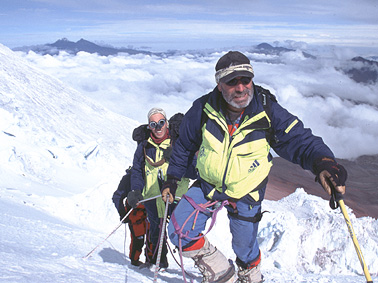
-
- Predictably and without him
realising at the time
- His pants split at the cruch, nearly freazing his most vital
piece of equipment ever. "It became useless and numb. I
had to warm it for half an hour in my hands." But more seriously,
all the teams were confronted with this cruel dilema : travel
light or in comfort ? For example a French team chose to use
a prototype 800 gr tent that's structure is assembled with the
team's walking sticks. Needless to say that the tent isn't much
protection in a mountain storm... On the other hand, other teams,
hoping to maintain a winners morale, allowed for more food and
rest. On the comfort side, all the walkers used telescopic walking
sticks which help to keep one's balance, limiting the chances
of tripping up and as a result save energy. This technique works
well and can be used by all those who enjoy long walks.
-
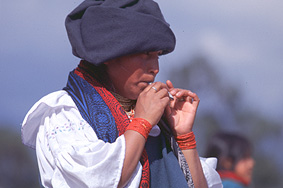 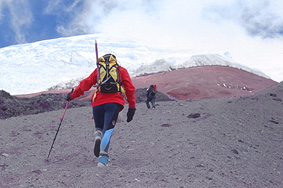
-
- After the high mountain,
the impenetrable jungle - From
his head quarters, situated in a luxurious acienda, a helicopter
ride away from the volcano, the technical organiser Alain Gaimard
admits he's satisfide : "The teams success on the Coto is
more than we hoped for as 95% of them made it to the top and
back". Paradoxically it was a few hours after he had started
to climb down and at the altitude of - only - 3800 m that one
member of the Paris fire bragade team suffered the begining of
an oedema. The efficient rescue team evacuated him to a hospital
in Quito, the second highest capital in the world (2800), where
he was kept for a short time only ...
-
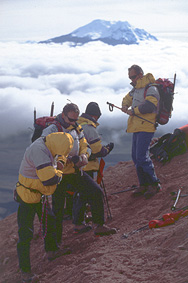 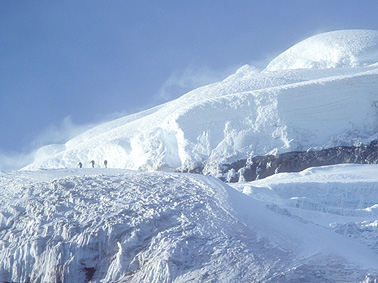
-
- "You can't just climb
6000 m without paying the price -
One of the trek's doctors explains. Even with an aclimatisation
period, the human body isn't designed to survive in this enviroment.
At high altitude, physical degeneration is quite quick."
Walking down Cotopaxi the majority of the teams look exhausted
but relieved.
-
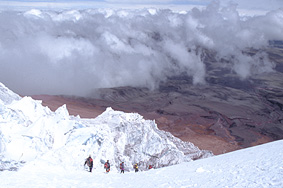 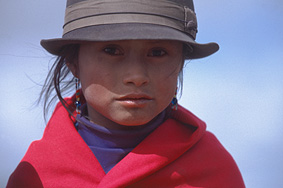
-
- But few are conscious of
what still lies ahead - And
what awaits them has little to do with a country outing : The
Indian bike (a sort of rustic mountain bike) ordeale, still at
high altitude, is a nightmare for many. And the last orientation
walk which follows takes place in the heart of an impenetrable
jungle. Swarms of mosquitoes, humidity and fog get the better
of many teams. One last, particularly slippery canyon followed
by a tyrolienne and it's time to start the water sports: 256
km worth of rafting, canoeing and sea-kayaking. The ultimate
effort which will enable the two leading teams to fight it out...
And the last ordeal for those who are competing against the clock
and hope to finish within the orthorised time.
-
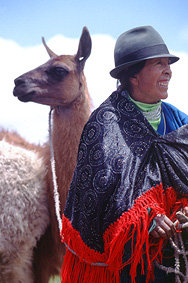 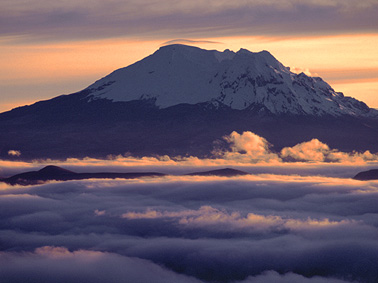
-
- A trek where half the teams
give up - At the back
of the race the number of drop outs is still rising. Due to the
hardships of the ascension half the teams cannot expect to figure
in the trek's official ranking. This is not the organisers fault,
the race was reasonably ambitious, but the dyre weather conditions
soon turned it into a terrible ordeal. To the point where the
jury decides to modify the rules slightly by improvising a new
ranking order called "Trans-Equator" for those teams
that are left too far behind : those that couldn't do some stages
of the race... and were repatriated by bus ! During the fireless
bivouacs (due to the incessant rain), the idea of the double
ranking is discussed by the worn out contesters... Is it possible
to have two races in one race : one for the pros and one for
the tourists ? Can a two-tier race remain credible ?
-
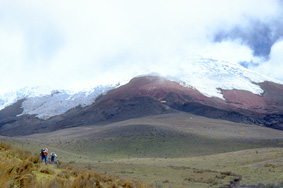 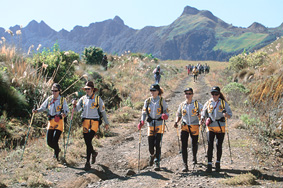
-
- Under the coconut trees,
on the exotic beach of Samé - Questions are being posed whilst we wait for the
first teams to arrive. As these days no professional sport is
safe from this practise, one of the questions concerns illegal
drug taking. On the trek like everywhere else, the temptation
to use a little "chemical boost" is great especially
as the subject isn't even mentioned in the rules and regulations
booklet ! Anyway, the achievement of those who get to the finishing
line is undiniable !
-
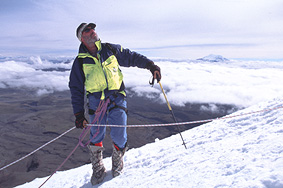 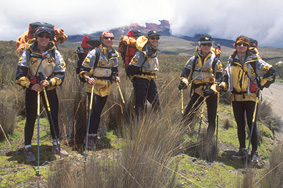
-
- When the Présidio
Salamon team finish -
literaly on all fours - their faces taught with pain, the tears
are hard to keep back... One hour and fifteen minutes later it's
the team from Spie-Batignolles' turn. As for Emma and her four
mates, they arrive two days later, but still before the official
dead-line. In the official ranking they are 22 nd ! Congratulations
girls because this was definitely the hardest trek ever.
-
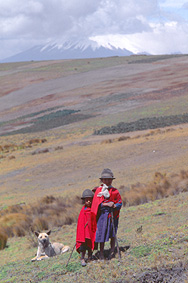 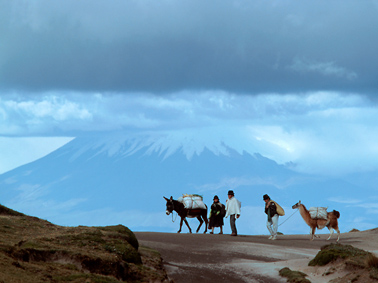
-
- © Jean François
VIBERT - Journalist and photographer - Paris -
-
- Specialised in travels, extrems
sports, leisure activities, adventure trips, outdoor sports,
deserts and mountains... Trekking, ski, snowboard, mountain,
bike, sailing, scuba diving, hiking, in line skating... Texts
and pictures for the press and the web, illustration, digital
photography, reportages...
|
- Journaliste photographe - Spécialiste
des voyages, des sports de glisse, des loisirs, de l'aventure,
de l'outdoor, des déserts, des montagnes. VTT, trekking,
ski, snowboard, parapente, voile, plongée sous marine,
randonnées, roller in line... Textes et photos pour la
presse et internet, illustrations, photographie numérique,
reportages...
|
|

|
|
 Nature here is superbe although agressive,
altitude sickness, unpradictable weather... The mountains of
the Equator are hard work ! Especially the ascent of Cotopaxi,
nearly 6000 m high... A reportage carried out for VSD during
the French trek named Raid Gauloise 98.
Nature here is superbe although agressive,
altitude sickness, unpradictable weather... The mountains of
the Equator are hard work ! Especially the ascent of Cotopaxi,
nearly 6000 m high... A reportage carried out for VSD during
the French trek named Raid Gauloise 98.



























